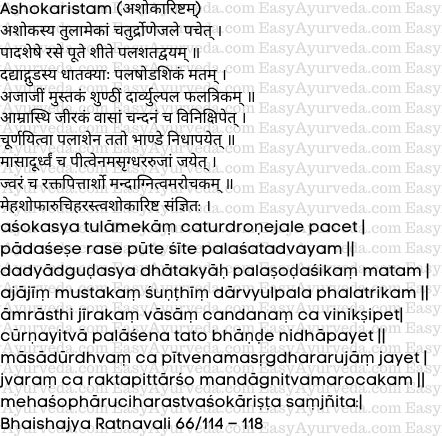Ashokarishta is an Ayurvedic medicine. It is extensively used in Ayurvedic treatment of heavy menstrual bleeding and other gynaecological complaints. It contains 5 – 10 % of self-generated alcohol, which acts as a medium for herbal active principles. This is also called as Asokarishtam.
Table of Contents
ToggleUses
It is used in Ayurveda treatments for many diseases like Pain menstruation, heavy periods, fever, bleeding disorders such as nasal bleeding, bleeding hemorrhoids, inflammation, indigestion and lack of taste.
It is useful in mid cycle spotting, painful periods with heavy bleeding.
Effects on Tridoshas: Balances Pitta Dosha.
Note:
1. It is usually prescribed by many Ayurvedic doctors for treating menstrual irregularities. If you have severe bleeding then Ashokarishtam may be helpful for you, but if you do have irregular prolonged cycle, then it is not a good idea to take this product. It is only helpful in short menstrual cycle and in heavy menstrual bleeding.
2. Though it is used primarily in female complaints, it is also useful in many other diseases as mentioned above.
3. Ashokarisht contains about 5 – 10 % of self generated natural alcohol in it. This self generated alcohol and the water present in the product acts as a media to deliver water and alcohol soluble the active herbal components to the body.
Other traditional uses of Ashokarishta –
Heavy menstrual bleeding – Asrigdhara
Useful in dysmenorrhoea – painful periods – Ruja
Fever – Jwara
Bleeding disorders like nasal bleeding – Raktapitta
Bleeding hemorrhoids – Arsha
Low digestion strength – Mandagni
Anorexia, lack of taste in food – Aruchi
Side effects
If given for wrong complaints, as mentioned above, it may cause delayed periods and prolonged menstrual cycles.
Dose
5 – 10 ml, once or twice a day, after food or as directed by Ayurvedic doctor. Those with irritation in the stomach can take this with equal quantity of water.
Adjuvants: Pravala bhasma.
How long to use?
Based on doctor’s prescription, this medicine can be used for 4-8 weeks in cases of fever, anorexia etc.
In heavy periods, it can be used during the periods, till the periods lasts.
If the periods are very heavy, then it can be taken from one week before periods sets in till it lasts.
In case of heavy periods nearing menopause or fibroids, Asokarishtam is advised for as long as 4 – 5 months time.
If I have heavy periods for 5 -7 days but if my cycle is regular with 30 days, should I take it all through the month or only during periods?
In this particular case, to control heavy bleeding and to take care of menstrual symptoms such as stomach pain, cramps, vomiting sensation etc, only during period days, Asokarishtam can be taken.
Safe for kids?
It is safe to use this medicine in lower dose, in children above 5 years of age.
Pregnancy and lactation –
During pregnancy, it is best to avoid this / take this only under medical supervision.
During lactation period, it can be taken in lower doses, based on doctor’s advice.
Using Ashokarishta while using other medicines:
Asokarist can be used by person taking other medicines for periods related problems or infertility treatment – such as Folic acid, Metformin, Intra uterine devices (IUD) etc.
With western medicines
Seek your doctor’s advice if you are taking this product along with other western (allopathic/modern) medicines. Some Ayurvedic herbs can interact with modern medicine.
If both Ayurvedic and allopathic medicines are advised together, then it is best to take allopathic medicine first, wait for 30 minutes and then, after a gap of 15 – 30 minutes, take Ayurvedic medicine or as directed by the physician.
Can this be used while taking Homeopathic medicine?
Yes. This product does not react with homeopathic medicine.
With supplements like multivitamin tablets, Omega 3 fatty acids etc?
Yes. Generally, this product goes well with most of the dietary supplements. However, if you are taking more than one product per day, please consult your doctor for an opinion.
Ingredients
Ashoka – Saraca asoka – Bark – 4.8 kg – It is a very potent styptic herb, useful to stop excessive bleeding.
water for decoction – 49.152 liters
Kashayam – decoction – 12.288 liters
Guda – jaggery – Saccharum officinarum – 9.6 kg
Prakshepa –
Dhataki – Woodfordia fruticosa – flower – 768 g – It acts as a fermenting agent.
Musta – Cyperus rotundus – Rhizome – 48 g – useful in treating infections.
Shunti – Ginger – Rhizome – 48 g
Ajaji – Nigella sativa – Fruit – 48 g
Daruharidra – Berberis aristata – Stem – 48 g
Utpala – Nymphaea stellata – flower – 48 g
Haritaki – Terminalia chebula – fruit – 48 g
Vibhitaki – Terminalia bellerica – fruit – 48 g
Amalaki – Amla – Indian gooseberry – fruit – 48 g – The above three fruits, together are called Triphala.
Amrasthi – mango seed – 48 g – Rich in astringent principles, useful to stop bleeding or to prolong menstrual cycle.
Jeeraka – cumin seed – 48 g – Very useful to relieve bloating, abdominal colic pain, associated with painful periods.
Vasa – Adhatoda vasica – whole plant – 48 g
Chandana – Santalum album (sandalwood) – 48 g – A coolant herb, useful to relieve excessive burning sensation, frequent urination, burning urination and urinary tract infection.
Method of preparation
The herbs mentioned are coarsely powdered and kashaya (water decoction) is prepared. The kashaya is strained and kept in the fermentation pot, vessel or barrel. Sugar, jaggery or honey, according to the formula, is dissolved, boiled, filtered and added. Drugs mentioned as Prakshepa Dravyas are finely powdered and added. At the end, Dhataki puspa, if included in the formula, should be properly cleaned and added. The mouth of the pot, vessel or barrel is covered with an earthen lid and the edges sealed with clay-smeared cloth wound in seven consecutive layers. The container is kept either in a heap of paddy, so as to ensure that for the duration of fermentation, as far as possible, a constant temperature may impede or accelerate the fermentation.
After the specified period, the lid is removed, and the contents examined to ascertain whether the process of fermentation has been completed. The fluid is first decanted and then strained after two or three days. When the fine suspended particles settle down, it is strained again and bottled.
Reference, Manufacturers
Bhaishajya Ratnavali Streeroga context 114-116
Manufacturers: Baidyanath, Dabur, AVN, AVP, Kottakkal, Sandu,
Nagarjuna – Ashokaarishtam
Shloka, Sanskrit Verse

Baidyanath Ashokarishta special
Baidyanath manufactures a special Ashoka arishta called as Ashokarishta special. It contains,
Ashok Chaal – Saraca asoka
Cumin seed – Jiraka – Cuminum cyminum
Motha – Cyperus rotundus
Triphala – Gooseberry, Chebulic myrobalan, Belleric myrobalan
Ginger – Sontha – Zingiber officinale
Mango seed – Amra – Mangifera indica
Malabar nut – Adulasa – Justicia adhatoda
Sandal wood – Chandan – Santalum album
Dhataki Puspa – Woodfordia fruticosa
Jaggery – Guda
Ashokarishta special is used in leucorrhoea, haematuria, menorrhagia, dysmenorrhoea and other female complaints associated with menstrual cycle.
Ashokarishta special can be given in the dose of 3 to 5 teaspoonful with equal quantity of water twice daily after meals. Or as directed by the physician.
Expiry date: 10 years from the date of manufacture. Once after opening, it is best to empty the bottle within 4 months time.
Storage: Store in a cool place in a tightly closed amber coloured bottle, protect from light and moisture.
When it is given for regularizing periods, what if the lady conceives? Is it harmful during pregnancy? Does Ashokarishta cause abortion?
It is commonly given in infertility treatment. It does not cause any harm if taken during pregnancy. But once after pregnancy is confirmed, there is no need of this medicine, as there is no need to regularize periods. Soon after pregnancy is confirmed, it is best to stop this medicine.
It does not cause abortion.
Can Asokarishta be taken during periods?
Yes. If it is advised for treating heavy periods, then it can be taken during periods.
Is it useful in leucorrhea (white discharge)?
Yes. Ashokarishta has potent anti microbial effect and is useful in the treatment of leucorrhea.
Is it useful in delayed periods?
No. It is useful only if the periods are heavy and if the menstrual cycles are short (once in 2 – 3 weeks time.
Is Ashokarist useful during menopause?
During when the menopause is approaching, there are chances of infection and prolonged bleeding. In such cases, Ashokarishta is very useful to control bleeding and to cause hormonal balance.
Can it be taken along with thyroid medication?
Usually thyroid medicine is given on empty stomach. Better to maintain a gap of 30 minutes between thyroid medicine and Ashokarishta.
Please consult your doctor before taking this medicine.
This article is written by Dr. Janardhana V Hebbar BAMS, MD (Ayu), PGDPSM, Managing Director, Easy Ayurveda Hospital.
It is reviewed by Dr. Raviganesh Mogra BAMS, MD (Ayu), Chief Medical Officer, Easy Ayurveda Hospital









11 thoughts on “Ashokarishta uses, dose, side effects and ingredients”
Hi…..I have very less bleeding …only for a day and that too very less…. Shall I take this medicine
After using ashokarista .. bleeding happens okay or required foctdo advise.
Sir,
My periods are heavy and last for 10days. Then red discharge come after that White discharge. After 10 days my period will come. That means 6days before the date.
Will it helpful? How to use it?
A woman have a 11 months girls baby. Can she take ashokarishta syrup.. Please reply
A friend of mine has pcod is 32 years. She is trying to have a baby. She consulted a doctor from kottakal and she put her on gynakot (2-0-2). Ashokaristam 30ml in the morning and kanchana guggulu 0-0-1. First 2 times she got her periods in 40 days third time after 50 days. Are these medicines enough ? Her doctor says you need to take this for at least for 6 months. Will this rectify because she is badly wants to conceive.
Sir, I have severe problem in my period. I have severe bleeding and severe stomach pain and my backbone became swelled during the time of period and stomach also swelled and I have severe pain in abdominal area an backbone also. So can I take Ashokarishta tonic for relief? And also my vaginal area has been infected during the time of period.
So can I take this tonic for relief?
sir, My Mother is 59 years old, her period is stopped 9 years before, 3 month before she got period lightly spotting and white discharge, we consulted Alopathy Gynecologist and adviced to take Ultra sound Scan, in that scan report found that the uterus wall ( Endometrium ) thicken subsequently did D &C and tissue sample were sent to pathological lab. the pathology report said there is no evidence for atypical and she is affected from endometrial polyps. she took alopathy medicine , the bleeding stopped. after 6 month should be reviewed. in future the polyps dont come again , she may take ashokaristam? kindly advice me pls
Hi
I am having Hashimoto Hypothyoid since 20 years. since 7 years i am having heavy periods,became anemic. I do not have any fibroids .please let me know can i take? how long should we take?
You can take it for 3 – 4 months time.
Hi, i have a doubt.i have pcod.i hav my period once in 3 or 4 month. During my period,i have very low flow. Shall i use this product? How long shall i use this product? Plz tell dosage also
No.